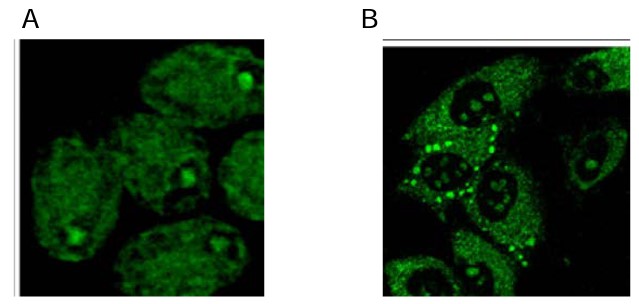Anti-8-hydroxyguanosine (8-oxoG) DNA/RNA Oxidative Damage Antibody
(Clone 15A3)
Anti-8-hydroxyguanosine (8-oxoG) DNA/RNA Oxidative Damage Antibody
(Clone 15A3)
Product No.: 12501
- -
- -
Clone 15A3 Target 8-oxoG Formats AvailableView All Product Type Monoclonal Alternate Names 8-oxoG, 8-Oxoguanine, 8-oxo-Gua Isotype Mouse IgG2b Applications ELISA , IHC , AP |
Data
- -
- -
Antibody DetailsProduct DetailsReactive Species Eukaryotic Host Species Mouse Immunogen 8-hydroxyguanosine (oh8G)-BSA and -casein conjugates. Product Concentration Lot Specific Formulation Tris-buffered saline (TBS), pH 7.4 State of Matter Liquid Product Preparation Purified by Protein G affinity chromatography Storage and Handling This antibody is stable for at least one (1) year at 4°C. Avoid repeated freeze-thaw cycles. Do not freeze as this might result in precipitation of the antibody. Country of Origin USA Shipping Next Day 2-8°C Applications and Recommended Usage? Quality Tested by Leinco IHC Protocol using Anti-DNA/RNA Oxidative Damage Antibody (12501) This antibody may be used in ELISA and immunohistochemistry to detect the markers of oxidative damage to DNA and RNA. May also be used on immunoaffinity columns to isolate oxidative DNA damage adducts from biological fluids. Each investigator should determine their own optimal working dilution for specific applications. See directions on lot specific datasheets, as information may periodically change. DescriptionSpecificity Mouse Monoclonal Antibody specific to DNA and RNA Oxidative Damage Markers Research Area DNA/RNA Damage, Oxidative stress References & Citations1. Park et al. (1992) Assay of excised oxidative DNA lesions: Isolation of 8-oxoguanine and its nucleoside derivatives from biological fluids with a monoclonal antibody column. Proc Natl Acad Sci (USA) 89: 3375- 3379. 2. Nunomura et al. (1999) RNA Oxidation is a prominent feature of vulnerable neurons in Alzheimer's Disease. J Neuroscience 19: 1959-1964. 3. Cui et al. (1999) Oxidative damage to the c-fos gene and reduction of its transcription after focal cerebral ischemia. J Neurochemistry 73:1164-1174. 4. Salganik et al. (2000) Dietary antioxidant depletion: enhancement of tumor apoptosis and inhibition of brain tumor growth in transgenic mice. Carcinogenesis 21: 909-914. 5. Tanaka et al. (2007) Oxidized messenger RNA induces translation errors. Proc Natl Acad Sci (USA) 104: 66-71. 6. Zhan et al. (2015) Localized control of oxidized RNA. Journal of Cell Science 128: 4210-4219. 7. Kharel et al. (2016) Evidence of extensive RNA oxidation in normal appearing cortex of multiple sclerosis brain. Neurochemistry International 92: 43-48. Technical ProtocolsCertificate of Analysis |
Formats Available
- -
- -
Prod No. | Description |
|---|---|
12501 |



